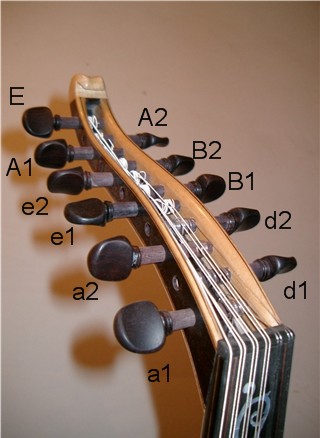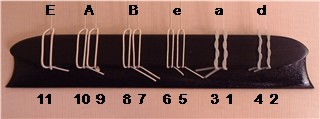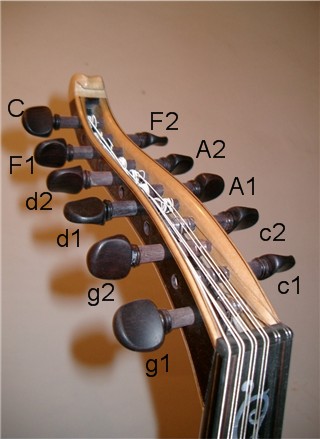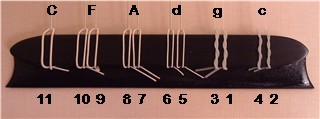
Turkish string to peg diagram
#1 corresponds to the string in the pair that is furthest to the right on the bridge with the oud facing you (or closest to the floor as you play). #2 corresponds to the string in each pair that is furthest to the left of the bridge (or closest to you while playing).
Get in touch if this doesn't make sense.
You should always wind the peg 'up' towards the end of the pegbox when tightening, and 'down' towards the oud's body when loosening.
How to best string your instrument when you need to change the strings:
~ Note, it is usually best to change all the strings together, to ensure an even tone quality across the whole instrument.
THE STRINGING ORDER AT THE BRIDGE
For a typical Turkish tuning:

It is recommended that you string your oud with this order at the bridge, to help prevent your strings from getting tangled in the pegbox.
**Suggested stringing order at the bridge taken from the Oud Method by Kyriakos Kalaitzidis, with some slight modifications by me.

Arabic string to peg diagram
#1 corresponds to the string in the pair that is furthest to the right on the bridge with the oud facing you (or closest to the floor as you play). #2 corresponds to the string in each pair that is furthest to the left of the bridge (or closest to you while playing).
Get in touch if this doesn't make sense.
You should always wind the peg 'up' towards the end of the pegbox when tightening, and 'down' towards the oud's body when loosening.
How to best string your instrument when you need to change the strings:
~ Note, it is usually best to change all the strings together, to ensure an even tone quality across the whole instrument.
THE STRINGING ORDER AT THE BRIDGE
For a typical Arabic tuning:

It is recommended that you string your oud with this order at the bridge, to help prevent your strings from getting tangled in the pegbox.
**Suggested stringing order at the bridge taken from the Oud Method by Kyriakos Kalaitzidis, with some slight modifications by me.
